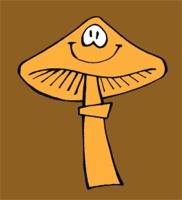|
|
|
|
|
Galleria Tassonomica
di
Natura Mediterraneo
|
|
|
| Autore |
 Discussione Discussione  |
|
|
gcarniolicus
Utente V.I.P.
  

Città: Tolmin
Regione: Slovenia

408 Messaggi
Micologia |
|
|
Alfredo
Utente Senior
   

Città: Torino
Regione: Piemonte

1893 Messaggi
Micologia |
 Inserito il - 24 febbraio 2005 : 11:11:58 Inserito il - 24 febbraio 2005 : 11:11:58


|
....aggiungerei anche la sidrome psicotropa ansiogena (infractinica) del C. infractus e la sindrome da T. ustale....e quella di Pleurocybella
ciao
Alf
Alfy |
 |
|
|
Gaspy
Utente Senior
   

Città: Trieste
Prov.: Trieste
Regione: Friuli-Venezia Giulia

1703 Messaggi
Micologia |
 Inserito il - 24 febbraio 2005 : 15:09:42 Inserito il - 24 febbraio 2005 : 15:09:42


|
Aggiungiamo anche la sindrome da Amanita smithiana.
Gaspy
B.Gasparini |
 |
|
|
Alfredo
Utente Senior
   

Città: Torino
Regione: Piemonte

1893 Messaggi
Micologia |
 Inserito il - 24 febbraio 2005 : 15:12:08 Inserito il - 24 febbraio 2005 : 15:12:08


|
Caro Gaspy, La sindrome di Amanita smithiana è la stessa di A. proxima, pseudoovoidea ed altre
Alfy |
 |
|
|
Gaspy
Utente Senior
   

Città: Trieste
Prov.: Trieste
Regione: Friuli-Venezia Giulia

1703 Messaggi
Micologia |
 Inserito il - 24 febbraio 2005 : 21:36:25 Inserito il - 24 febbraio 2005 : 21:36:25


|
Ne sono convinto, ma ....non tutti sanno che si tratta di una sindrome alquanto oscura che era addirittura scambiata per sindrome paraorellaninea. Quando ne lessi lo studio (Tullos, R.E. & Lindgren J.E. (1992) Amanita smithiana - taxonomy, distribuition and poisoning - Mycotaxon 45: 373-387), il principio tossico era ignorato. Si sa qualcosa di più oggi?
Gaspy
B.Gasparini |
 |
|
|
doni
Utente V.I.P.
  

Città: Lecce
Prov.: Lecce
Regione: Puglia

175 Messaggi
Tutti i Forum |
 Inserito il - 24 febbraio 2005 : 22:18:49 Inserito il - 24 febbraio 2005 : 22:18:49


|
Solo un piccolo commento di ordine pratico, spesso viene consumato un misto di funghi tossici per cui può comparire prima una sindrome a breve latenza che maschera la comparsa di una sindrome a lunga latenza.
Donatella |
 |
|
|
Alfredo
Utente Senior
   

Città: Torino
Regione: Piemonte

1893 Messaggi
Micologia |
 Inserito il - 25 febbraio 2005 : 14:58:54 Inserito il - 25 febbraio 2005 : 14:58:54


|
Caro Gaspy, ne sappiamo moltissimo di più, sono usciti numerosissimi lavori dopo e prima quello di Tulloss: sono implcati aminoacidi particolari.....per saperne di più posso mandare agli interessati qualche articolo
ciao
Alfy |
 |
|
|
verna
Utente Senior
   

Città: sant'agata militello
Prov.: Messina
Regione: Sicilia

1501 Messaggi
Micologia |
 Inserito il - 25 febbraio 2005 : 17:10:53 Inserito il - 25 febbraio 2005 : 17:10:53


|
e se si cerca con cura ed attenzione, gli stessi particolari aminoacidi potrebbero essere evidenziati anche nella A. ovoidea (da sempre considerata commestibile).
Sono stato testimone (come medico) di un grave caso di Sindrome gastrointestinale dopo ingestione di suddetta specie.
Andrea.
|
 |
|
|
Gaspy
Utente Senior
   

Città: Trieste
Prov.: Trieste
Regione: Friuli-Venezia Giulia

1703 Messaggi
Micologia |
 Inserito il - 26 febbraio 2005 : 10:24:45 Inserito il - 26 febbraio 2005 : 10:24:45


|
Per Alfy e Andrea
Sarei veramete interessato a leggere la documentazione su questo gruppo di funghi tossici. Se mi invierete copie bibliografiche ve ne sarò grato.
Grazie e ciao
Gaspy
B.Gasparini |
 |
|
|
verna
Utente Senior
   

Città: sant'agata militello
Prov.: Messina
Regione: Sicilia

1501 Messaggi
Micologia |
 Inserito il - 26 febbraio 2005 : 13:38:24 Inserito il - 26 febbraio 2005 : 13:38:24


|
ciao Bruno
sull'Amanita ovoidea non posso inviarti che la mia semplice e personale relazione di una sindrome grastrointestinale, di notevole entità, di cui è stata vittima una mia paziente di 38 anni.
ciao, Andrea. |
 |
|
|
Gaspy
Utente Senior
   

Città: Trieste
Prov.: Trieste
Regione: Friuli-Venezia Giulia

1703 Messaggi
Micologia |
 Inserito il - 26 febbraio 2005 : 18:45:32 Inserito il - 26 febbraio 2005 : 18:45:32


|
Caro Andrea
mi occupavo di sindromi ancora in contatto con il famoso dott. Bastien.
Quindi tutti su questo argomento (così come le pubblicazioni sui pigmenti [metaboliti secondari]) mio interessa.
Gradirò perciò leggere la tua relazione così come ricevere da Alfy articoli sugli aminoacidi di questo gruppo di amanite.
Ricordo anni fà l' esperienza di un medico-micologo (Euro Marchetti responsabile del primo acoglimento dell' ospedale di Tolmezzo)
Un gruppo di persone cenò consumando Clitocybe gibba. La notte tutte le donne (mi pare cinque) stettero male, gli uomini nessun disturbo.
Io negli anni settanta ho <<validato>> una rccolta di Suillus granulatus e Chrogomphus rutilus. Li consumarono in tre. La donna stette così male che non volle più mangiare funghi. Nulla accadde agli uomini. Stranpo fenomeno di cui si dovrebbe esaminare la statistica.
Forse si spiega con il fatto che le donne sono non una specie, ma un enere diverso dagli uomini!!!!!!
Gaspy
B.Gasparini |
 |
|
|
gcarniolicus
Utente V.I.P.
  

Città: Tolmin
Regione: Slovenia

408 Messaggi
Micologia |
 Inserito il - 26 febbraio 2005 : 20:18:06 Inserito il - 26 febbraio 2005 : 20:18:06


|
Ciao a tutti!
Bruno, il lunedi ti faccio sapere i quali posso scaricare direttamente.
Buona domenica,
Gregor
---------------
1.-su A.proxima
de Haro L, Jouglard J, Arditti J, David JM.
[Acute renal insufficiency caused by Amanita proxima poisoning: experience of the Poison Center of Marseille]
Nephrologie. 1998;19(1):21-4. French.
Ducros J, Labastie J, Saingra S.
[A supplementary case of Amanita Proxima poisoning as the origin of acute renal insufficiency]
Nephrologie. 1995;16(4):341.
Leray H, Canaud B, Andary C, Klouche K, Beraud JJ, Mion C.
Amanita proxima poisoning: a new cause of acute renal insufficiency]
Nephrologie. 1994;15(3):197-9. French.
2,-su A.smithiana
Acad Emerg Med. 1998 Aug;5(8):808-12.
Acute renal failure associated with suspected Amanita smithiana mushroom ingestions: a case series.
Warden CR, Benjamin DR.
Department of Emergency Medicine, Oregon Health Sciences University, Portland 97201-3098, USA. wardenc@ohsu.edu
Abstract.
Mushroom poisoning leading to acute renal failure is extremely rare in North America. Cortinarius species and Amanita smithiana both can cause acute renal failure and inhabit the Pacific northwest. This article describes 4 patients who presented in acute renal failure and who ingested mushrooms described as resembling A. smithiana. Two patients (a 74-year-old Korean couple) described eating mushrooms with an approximately 6 x 0.5-inch stipe with a white cap, 1.25-1.5 inches in diameter. The other 2 patients (a 55-year-old male and a 30-year-old female) also described a white-capped mushroom. All believed they were eating the matsutake (Tricholoma magnivalere) mushroom, which can be mistaken for A. smithiana. Onset of gastrointestinal symptoms ranged from 20 minutes to 12 hours, and presentation in acute renal failure ranged from 4 to 6 days postingestion (initial BUN and creatinine were 72-91 mg/dL and 12-13.9 mg/dL, respectively). One patient had underlying mild renal insufficiency and one had hypertension that was under control, while the others had no risk factors for renal disease. None had any other explanation for the episode of acute renal failure. All underwent acute hemodialysis for at least several weeks, eventually returning to baseline renal function.
J Toxicol Clin Toxicol.1997;35(1):67-75.
Renal failure caused by mushroom poisoning.
Leathem AM, Purssell RA, Chan VR, Kroeger PD.
University of British Columbia, Vancouver, Canada.
Abstract.
BACKGROUND: In the Pacific Northwest region of the US and in southwestern British Columbia, Canada, isolated cases of renal failure have occurred following ingestion of wild mushrooms. We report four cases in which toxic mushrooms were mistaken for the edible pine mushroom or matsutake (Tricholoma magnivelare). CASE REPORTS: Gastrointestinal symptoms started five to eight hours after ingestion and continued for several days. Three of the four patients were found to be in renal failure when they presented to the emergency department 5-6 days post ingestion. One patient, an elderly diabetic, had renal dysfunction the day following ingestion. All patients received hemodialysis and supportive care and regained renal function. DISCUSSION: Symptoms and time of onset are similar to those reported in previous cases of Amanita smithiana poisoning. This suggests that the mushroom involved in these cases may also be Amanita smithiana which contains nephrotoxic compounds. In one of the cases, stem ends of the mushrooms were available for examination. Cellular elements conforming to those described as being present in the species Amanita smithiana were seen on light microscopy. CONCLUSION: Mushroom field guides warn against mistaking Amanita smithiana for pine mushrooms. They are similar in size, color and habitat. It appears possible that Amanita smithiana mushrooms were eaten instead of pine mushrooms in these cases.
Lloydia. 1976 Mar-Jun;39(2-3):150-7.
Toxic metabolites of Amanita pantherina, A. cothurnata, A. muscaria and other Amanita species.
Chilton WS, Ott J.
Abstract.
Forty-seven specimens representing 35 species or varieties of Amanita were examined for the presence of ibotenic acid, muscimol, stizolobic acid, stizolobinic acid, aminohexadienoic acid and chlorocrotylglycine. In addition, crude extracts of A. muscaria were examined chromatographically for the presence of methyltetrahydrocarboline carboxylic acid (MTC). Ibotenic acid and muscimol were found in clearly detectable concentrations in extracts of A. cothurnata, all specimens of A. muscaria, all specimens of A. pantherina and in lower concentrations in A. gemmata. Stizolobic acid and stizobinic acid were found in detectable concentrations in one variety of A. muscaria, in all specimens of A. pantherina and in trace levels after additional purification of the extracts in A. gemmata and in the remaining specimens of A. muscaria. Aminohexadienoic acid and chlorocrotylglycine were detected only in crude extracts of A. smithiana. MTC could not be detected in crude extracts of A. muscaria. Crystalline ibotenic acid (820 mg) was isolated from 17 kg of a specimen of A. pantherina collected in western Washington State.
------------------------
3.due lavori recenti:
Crit Care Med. 2005 Feb;33(2):427-436.
Syndromic diagnosis and management of confirmed mushroom poisonings.
Diaz JH.
From Programs in Community Preventive Medicine and in Environmental and Occupational Health Sciences, School of Public Health, and the Departments of Anesthesiology, Emergency Medicine, and Family Medicine, School of Medicine, Louisiana State University Health Sciences Center, New Orleans, LA.
OBJECTIVE:: To assess the evolving global epidemiology of mushroom poisoning and to identify new and emerging mushroom poisonings and their treatments, a descriptive analysis and review of the world's salient scientific literature on mushroom poisoning was conducted. DATA SOURCE:: Data sources from observation studies conducted over the period 1959-2002, and describing 28,018 mushroom poisonings since 1951, were collected from case reports, case series, regional descriptive studies, meta-analyses, and laboratory studies of mushroom poisonings and the toxicokinetics of mycotoxins. STUDY SELECTION:: Studies included in the review were selected by a MEDLINE search, 1966-2004, an Ovid OLDMEDLINE search, 1951-1965, and a medical library search for sources published before 1951. DATA EXTRACTION:: To better guide clinicians in establishing diagnoses and implementing therapies, despite confusing ingestion histories, data were extracted to permit an expanded syndromic classification of mushroom poisoning based on presentation timing and target organ systemic toxicity. DATA SYNTHESIS:: The final 14 major syndromes of mushroom poisoning were stratified first by presentation timing and then by target organ systemic toxicity and included early (<6 hrs), late (6-24 hrs), and delayed syndromes (>/=1 day). There were eight early syndromes (four neurotoxic, two gastrointestinal, two allergic); three late syndromes (hepatotoxic, accelerated nephrotoxic, erythromelalgia); and three delayed syndromes (delayed nephrotoxic, delayed neurotoxic, rhabdomyolysis). Four new mushroom poisoning syndromes were classified including accelerated nephrotoxicity (Amanita proxima, Amanita smithiana), rhabdomyolysis (Tricholoma equestre, Russula subnigricans), erythromelalgia (Clitocybe amoenolens, Clitocybe acromelalgia), and delayed neurotoxicity (Hapalopilus rutilans). In addition, data sources were stratified by three chronological time periods with >1,000 confirmed mushroom ingestions reported and tested for any statistically significant secular trends in case fatalities from mushroom ingestions over the entire study period, 1951-2002. CONCLUSIONS:: Since the 1950s, reports of severe and fatal mushroom poisonings have increased worldwide. Clinicians must consider mushroom poisoning in the evaluation of all patients who may be intoxicated by natural substances. Since information on natural exposures is often insufficient and incorrect, a new syndromic classification of mushroom poisoning is recommended to guide clinicians in making earlier diagnoses, especially in cases where only advanced critical care, including organ transplantation, may be life saving.
Crit Care Med. 2005 Feb;33(2):419-426.
Evolving global epidemiology, syndromic classification, general management, and prevention of unknown mushroom poisonings.
Diaz JH.
From Programs in Community Preventive Medicine and in Environmental and Occupational Health Sciences, School of Public Health, and the Departments of Anesthesiology, Emergency Medicine, and Family Medicine, School of Medicine, Louisiana State University Health Sciences Center, New Orleans, LA.
OBJECTIVE:: To assess the evolving global epidemiology of mushroom poisoning and to identify new and emerging mushroom poisonings and their treatments, a descriptive analysis and review of the world's salient scientific literature on mushroom poisoning was conducted. DATA SOURCE:: Data sources from observation studies conducted over the period 1959-2002 and describing 28,018 mushroom poisonings since 1951 were collected from case reports, case series, regional descriptive studies, meta-analyses, and laboratory studies of mushroom poisonings and the toxicokinetics of mycotoxins. STUDY SELECTION:: Studies included in the review were selected by a MEDLINE search, 1966-2004, an Ovid OLDMEDLINE search, 1951-1965, and a medical library search for sources published before 1951. DATA EXTRACTION:: To better guide clinicians in establishing diagnoses and implementing therapies, despite confusing ingestion histories, data were extracted to permit an expanded syndromic classification of mushroom poisoning based on presentation timing and target organ systemic toxicity. DATA SYNTHESIS:: The final 14 major syndromes of mushroom poisoning were stratified first by presentation timing and then by target organ systemic toxicity and included early (<6 hrs), late (6-24 hrs), and delayed syndromes (>/=1 day). There were eight early syndromes (four neurotoxic, two gastrointestinal, two allergic); three late syndromes (hepatotoxic, accelerated nephrotoxic, erythromelalgia); and three delayed syndromes (delayed nephrotoxic, delayed neurotoxic, rhabdomyolysis). Four new mushroom poisoning syndromes were classified including accelerated nephrotoxicity (Amanita proxima, Amanita smithiana), rhabdomyolysis (Tricholoma equestre, Russula subnigricans), erythromelalgia (Clitocybe amoenolens, Clitocybe acromelalgia), and delayed neurotoxicity (Hapalopilus rutilans). In addition, data sources were stratified by three chronological time periods with >1,000 confirmed mushroom ingestions reported and tested for any statistically significant secular trends in case fatalities from mushroom ingestions over the entire study period, 1951-2002. CONCLUSIONS:: Since the 1950s, reports of severe and fatal mushroom poisonings have increased worldwide. Clinicians must consider mushroom poisoning in the evaluation of all patients who may be intoxicated by natural substances. Since information on natural exposures is often insufficient and incorrect, a new syndromic classification of mushroom poisoning is recommended to guide clinicians in making earlier diagnoses, especially in cases where only advanced critical care, including organ transplantation, may be life saving. |
 |
|
|
FOX
Moderatore
    

Città: BAGNO A RIPOLI
Regione: Toscana

21536 Messaggi
Tutti i Forum |
 Inserito il - 27 febbraio 2005 : 10:42:48 Inserito il - 27 febbraio 2005 : 10:42:48


|
Ciao amici,
Avete lasciato una sindrome!
Quella dei c.......i....
Alcuni anni fa un amico che si occupava di tossicologia mi ha raccontato che un tizio (poi ho avuto la possibilità di conoscerlo) pur sapendo di essere intollerante a tutti Agaricus....creandogli una vera e seria intossicazione, una volta tornato a casa e ristabilito ...continuava a mangiarli....così ogni volta è costretto ad andare in ospedale...
Fox   |
 |
|
|
Gaspy
Utente Senior
   

Città: Trieste
Prov.: Trieste
Regione: Friuli-Venezia Giulia

1703 Messaggi
Micologia |
 Inserito il - 27 febbraio 2005 : 11:50:27 Inserito il - 27 febbraio 2005 : 11:50:27


|
Citazione:
Messaggio inserito da FOX
Ciao amici,
Avete lasciato una sindrome!
Quella dei c.......i....
Ecco unn luogo comune del tutto sbagliato: i c.......i....generalmente non fanno danno e sono fonte di piacere. Quelli che vengono così appellati sanno fare danno solo a sè e sovente agli altri
Gaspy!
Alcuni anni fa un amico che si occupava di tossicologia mi ha raccontato che un tizio (poi ho avuto la possibilità di conoscerlo) pur sapendo di essere intollerante a tutti Agaricus....creandogli una vera e seria intossicazione, una volta tornato a casa e ristabilito ...continuava a mangiarli....così ogni volta è costretto ad andare in ospedale...
Fox  
B.Gasparini |
 |
|
|
Artù
Utente V.I.P.
  
Città: Lecce
Prov.: Lecce
Regione: Puglia

414 Messaggi
Tutti i Forum |
 Inserito il - 27 febbraio 2005 : 15:46:29 Inserito il - 27 febbraio 2005 : 15:46:29


|
Ovoide è regolarmente consumato dalla notte dei tempi "fungi lardari" ciononostante non ho dati certi su intossicazioni e le uniche riferite al consimo di ovoidea erano in realtà legate al consumo di proxima. Perltro so, e Verna lo conferma, di molti casi sicuramente attribuilbili ad ovoidea.
Se avete qualcosa sulla proximien e sulle altre (recente) ve ne sarei grato se vorrete considerarmi nella spedizione.
Ciao a tutti
Arturo
-----
".. ho viste cose che voi umani non potreste nemmeno immaginare... e tutti quei momenti andranno perduti nel tempo come lacrime nella pioggia." |
 |
|
|
Gaspy
Utente Senior
   

Città: Trieste
Prov.: Trieste
Regione: Friuli-Venezia Giulia

1703 Messaggi
Micologia |
 Inserito il - 28 febbraio 2005 : 09:45:49 Inserito il - 28 febbraio 2005 : 09:45:49


|
Caro Artù,
Ciò chc scrivi è possibile.
Ma l' evidenza dei fatti (non circostanziati nel caso dell'A.ovoidea/proxima)dimostra che esistono funghi con tossicità incostante.
La stessa A. muscaria può essere consumata senza conseguenze o dare gravi avvelenamenti. E lo steso avviene per la Clitocybe nebularis (largamente consumata), altre Citocybe, Armillaria mellea, Tricholoma equeste, Cortinarius splendens, ecc.
Sono state avanzate diverse ipotesi. Ma la più credibile (e ciò ci porta ad un approfondimento micologico) è che i metaboliti secondari (non soltanto le varie sostanze tossiche, ma anche i vari pigmenti)si formano con una certa incostanza, possono essere presenti o assenti o in forma ridotta.
Ecco perché le varie forme prtroppo spesso elevatre a varietà o addirittura a specie dovrebbero essere considerate con maggior prudenza. Ne parleremo nel capitolo dedicato allo studio della micologia.
Gaspy
B.Gasparini |
 |
|
|
Artù
Utente V.I.P.
  
Città: Lecce
Prov.: Lecce
Regione: Puglia

414 Messaggi
Tutti i Forum |
 Inserito il - 28 febbraio 2005 : 15:27:18 Inserito il - 28 febbraio 2005 : 15:27:18


|
Anche se tutte le notizie, erano già nel mio bagaglio scientifico, ti ringrazio per le precisazioni sicuramente utili a tanti altri amici. Ho anche approfondito ma senza arrivare ad una conclusione la letteratura (piuttosto scarna) sui metaboliti secondari incostanti: su questi mi piacerebbe avere qualche notizia recente.
Saluti
Arturo
-----
".. ho viste cose che voi umani non potreste nemmeno immaginare... e tutti quei momenti andranno perduti nel tempo come lacrime nella pioggia." |
 |
|
|
gcarniolicus
Utente V.I.P.
  

Città: Tolmin
Regione: Slovenia

408 Messaggi
Micologia |
 Inserito il - 28 febbraio 2005 : 19:13:30 Inserito il - 28 febbraio 2005 : 19:13:30


|
Citazione:
Messaggio inserito da gcarniolicus
Ciao a tutti!
Bruno, il lunedi ti faccio sapere i quali posso scaricare direttamente.
Ciao Bruno,Arturo,
la Nephrologie non hanno in abbonato, mentre l'altra rivista Crit.Care Med. si .La bibliotecaria mi parla delle licence ed anche io non sono iscrito a quella biblioteca.
Importante e che avete gia letto i lavori di Saviuc et coll.E quello su acido ustalico ed su Pleurocybella porrigens...
Gregor
|
 |
|
|
Alfredo
Utente Senior
   

Città: Torino
Regione: Piemonte

1893 Messaggi
Micologia |
 Inserito il - 01 marzo 2005 : 09:45:33 Inserito il - 01 marzo 2005 : 09:45:33


|
Li ho tutti, anche quelli su Nephrologie, ditemi quali vi servono...
Alfy |
 |
|
|
gcarniolicus
Utente V.I.P.
  

Città: Tolmin
Regione: Slovenia

408 Messaggi
Micologia |
 Inserito il - 01 marzo 2005 : 16:32:46 Inserito il - 01 marzo 2005 : 16:32:46


|
Ciao,
dimenticavo aggiungere le allergie provvocate da Lycoperdon, e quelle di acido poliporico(anche in ****ake)..
Il lavoro di Diaz e buono, aggiornato, utile...comparendo a queli ( su micotossine)
Link
Link
Un salutone,
Gregor
P.S.
Ah, che censura... va bene, scrivo Lentinula edodes.
 |
Modificato da - gcarniolicus in data 01 marzo 2005 16:36:22 |
 |
|
|
Daniele
Utente V.I.P.
  

Città: Sesto San Giovanni
Prov.: Milano
Regione: Lombardia

292 Messaggi
Micologia |
 Inserito il - 01 marzo 2005 : 17:52:13 Inserito il - 01 marzo 2005 : 17:52:13


|
Lievemente O.T. ( ma nemmeno tanto)
Domenica scorsa, nel corso del 99° Seminario di Micologia del Centro Micologico Lombardo, ho avuto modo di incrociare Villa, il Presidente dell'A.M.B. e, appena reduce dalla mia prolusione sui metodi statistici nello studio dei myceti, ho chiesto al Presidente:"perchè non istituiamo un ufficio statistico all'interno del Comitato Scientifico Nazionale, in modo da approfondire i molti temi che la micologia pone ?"
Mi ha detto che è una idea interessante e che la sosterrà in seno agli organismi preposti.
Per tornare a noi e alla micotossicologia.
E' evidente che la tossicità dei funghi può dipendere da un insieme complesso di variabili.
Si tratta di costruire dei modelli multivariati, che tengano conto di tutti i "fattori di rischio" noti e meno noti.
E' necessario costruire delle matrici in grado di dare delle risposte adeguate.
Sicuramente esistono degli elementi di causalità nella tossicità.
La "regione critica" è meno evidente in quelle specie considerate eduli, che, in alcuni soggetti e in alcune aree geografiche hanno procurato avvelenamenti anche gravi.
Ricerche di questo tipo non sono semplici e nemmeno brevi.
E' necessaria una accurata ricerca bibliografica, non sempre disponibile, una corretta programmazione del disegno sperimentale, test di laboratorio, rilevazione dei dati e analisi degli stessi, inferenze sulla popolazione.
Però , se mai si comincia, mai si arriva da nessuna parte.
Alcuni anni fa Vescovi e Cocchi hanno iniziato un lavoro egregio sulla tossicità degli agaricus ( anche di quelli ritenuti normalmente eduli) per via del forte assorbimento dei metalli pesanti, caratteristica elettiva di questo genere.
I dati disponibili indicano che vi è sempre una correlazione tra fungo e territorio che, in senso assoluto, non si può mai escludere la tossicità; anche in presenza di connotazione come "edibile".
Staremo a vedere, se si potrà fare qualche passo in avanti;
Altrimenti continueremo sempre a interrogarci come Don Ferrante ne' "I Promessi Sposi" a proposito dell'origine della peste. |
 |
|
| |
 Discussione Discussione  |
|
|
|
 Natura Mediterraneo Natura Mediterraneo |
© 2003-2024 Natura Mediterraneo |
 |
|
Leps.it | Herp.it | Lynkos.net
|

 Forum
|
Registrati
|
Msg attivi
|
Msg Recenti
|
Msg Pvt
|
Utenti
|
Galleria |
Map |
Forum
|
Registrati
|
Msg attivi
|
Msg Recenti
|
Msg Pvt
|
Utenti
|
Galleria |
Map |